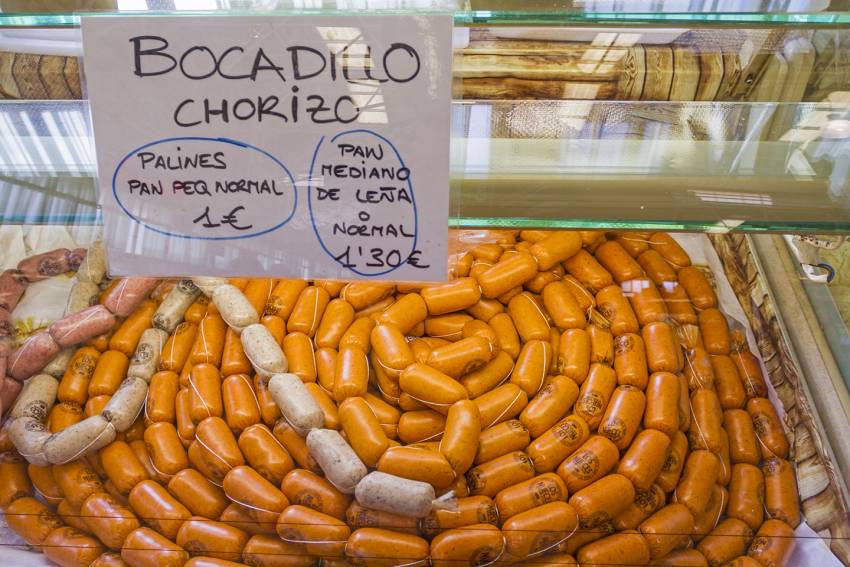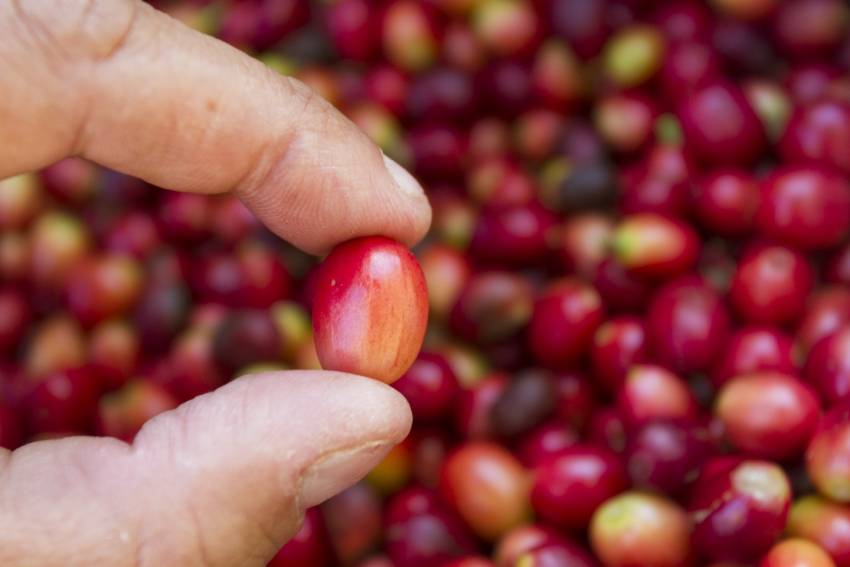The Top Ten Canarian Foods That Everybody Should Try
Canarian food is one of the highlights of a holiday in Gran Canaria. Try it in local restaurants in the capital Las Palmas or in the hill towns. The Canary Islands dishes served in the resorts are rarely any good.
Papas Arrugadas
The Canarian dish that everybody tries and most people love. Papas arrugadas or wrinkly potatoes are small potatoes boiled their skin in sea water until the wrinkle up and develop a thin crust of salt. They are served covered with Mojo Picon, a spicy sauce made of olive oil, cumin,chili peppers, raw garlic and vinegar. The Canarian word of potato is papa, which also means pope. Some mistranslated English menus describe papas arrugadas as “wrinkly popes”!
Gofio
The staple diet of the pre-Hispanic indigenous Canarians, who did not survive the Spanish colonisation of the island, gofio is a nutritious flour made from pre-roasted barley or maize. Add it to coffee for a stomach-lining breakfast or try gofio escaldado, a sort of thick porridge flavoured with mint and eaten with raw red onions. Gofio is an acquired taste!
Sancocho Canario
A festival dish that is served on Sundays and at local Romerias (Canarian fiestas), Sancocho is a stew made from salted cod fish and sweet potato. Sancocho is traditionally served with pella de gofio, a soft paste made out of roasted maize flower and water. Sancocho is various forms can be found all over South America but the Canarian version is the original.
To be perfectly honest sancocho is incredibly fishy and salty and hardly anyone who isn't Canarian likes it.
Tropical Fruit
The subtropical climate of Gran Canaria means that it is one of the only places in Europe that can grow tropical fruit. Mangos, papayas, cactus fruit (tunos), pineapples, guavas, water melons and of course bananas are all grown locally and can be found in the main shops and markets. Canarian bananas are smaller than Caribbean ones and much tastier!
Ropa Vieja
Literally translated as “old clothes”, ropa vieja is a tasty stew made from chickpeas and chicken or beef, flavoured with bay leaves. Traditionally it was made from the meat leftover after making soups. There is a local myth that ropa vieja was invented by a man so poor that he made soup out of his clothes, which turned into this delicious dish.
Potaje
A thick and tasty vegetable soup made from potatoes, corn cobs and mixed vegetables, often with lots of watercress in it. Potaje is a good option for vegetarians. Most local restaurants make a different potaje every day.
Carne de Cabra
There is nothing better than slow-cooked, fatty goat meat served in huge portions. While lots of people think goat meat has a very strong taste, the Canarian way of stewing it on the bone makes it juicy and delicious.
Pata Asada
A staple snack, pata asada is roast pork, served cold sprinkled with sea salt. Done well it is moist and addictive! Done badly, it is shoe leather!
Squid and Octopus
There aren't many crabs and lobsters around Gran Canaria but there is plenty of squid, octopus and cuttlefish and Canarian cooks do them all justice. Squid is fried in rings (calamares fritos) and soaked in lemon juice and octopus is sliced thinly and served covered in sea salt and paprika (pulpo a la Gallega). Tiny squids are deep fried and served whole (puntitas de calamar) while cuttlefish are stewed with potatoes (choco en salsa)
Deserts
Truchas de batata are similar to turnovers and are filled with sweet potato while huevos mole is thick custard flavoured with lemon peel and cinnamon. With any desert, ask if it is home made (casero) to avoid disappointment. Mazapan is dense shortcake made from almond flour that is sold in the mountain villages.Also don't miss Guarapo, a sweet, almost black syrup made only on La Gomera from palm tree sap.
The Top Ten Scary Canarian Foods
There's nothing scary about a plate of papas con mojo, except perhaps the next day's garlic breath. However, there are plenty of Canarian dishes that make visitors squeamish. Here's the top ten for you to try.
The Top Five Local Gourmet Gran Canaria Foods
Flor de Guia Cheese
Moist and slightly bitter with a faint taste of grass and old socks: Gran Canaria’s Flor de Guía is the island’s most distinctive cheese. It is still made by traditional methods and is protected by a EU Designation of Origin. It is also one of the few cheeses that uses natural vegetable rennet (extracted from thistle or cardoon flowers) rather than animal rennet. This makes it suitable for vegetarians.
Creamy flor de Guia cheese has a soft, yellow rind and is creamy and riddled with small holes. It normally made in thin wheels about four inches deep.
You can buy Flor de Guia in the shops but it isn’t the real stuff. Most of the vacuum packed supermarket stuff is media flor made with a mixture or animal and vegetable rennet. It tends to be much denser and dryer than pure flor de Guia. For the genuine article head to the cheese stall at one of the island’s markets. Guia town itself has a tiny Sunday market in front of the church but nearby Galdar’s Thursday market is much bigger.
Agaete Coffee
A small bag of Gran Canaria coffee costs over 15 euros because it is only grown in the mild Agaete Valley. Known as Europe’s only coffee but a more accurate description is the most northerly coffee in the world.
Coffee was first grown in Gran Canaria in 1788 but faded away except in Agaete where the farmers grew if for their own morning cuppa. The bushes grow organically in the shade of mango, papaya and orange trees. Gran Canaria coffee beans are hand picked and sun dried and yield a delicate, fruity coffee with a hint of liquorice. Pretty tasty!
Right now Gran Canaria coffe is expensive but we’ve noticed a lot of coffee bushes lining banana plantations in the hills behind Galdar and Arucas. It won’t be long before the supply increases.
Temisas Olive Oil
Olive trees live a long time and don’t bear grudges. That’s just as well considering that Gran Canaria neglected its groves for over 100 years. Most of the ripe olives rotted on the ground and even the ones that got harvested were pickled ferociously in mojo.
The somebody tested the oil from the gnarled old trees and found that it is first class. Now Gran Canaria’s olivos are the island’s latest way of turning the sunshine into gold.
Farmers are busy learning the skills that their grandparents forgot and new groves go in every year. The best Gran Canaria olive oil comes from the old trees around Temisas, the town with longest history of olive growing in the Canary Islands.
Temisas’ grizzled survivors are old varieties that have died out everywhere else in Spain. Their oil is fruity and herbal with a good peppery kick and a distinctive smell of ripe tomatoes.
Gran Canaria’s olives are harvested by hand and cold pressed. A small bottle costs about 5 euros and is best served on salads or used plain as a dip for fresh bread.
Fresh Tropical Fruit
The best tropical fruit in Gran Canaria never makes the supermarkets. It’s sold in local markets and village shops. Look out for boxes of fruit that smells fantastic and has fresh green leaves still attached.
Because Gran Canaria is so high we also grow fabulous soft fruit like peaches, apricots, plums, apples and pears. Gran Canaria’s oranges are fantastic, especially the huge navel oranges that ripen during the winter.
Gran Canaria’s bananas are fantastic and taste far better than the Caribbean bananas you get in European supermarkets. It’s because they are a sweet variety and are picked ripe and never refrigerated. Bananas are available all year round.
Gran Canaria’s pineapples are delicious and are available most of the year. Only buy them if you can smell them. Papayas are harder to judge but go for the deepest colour orange or red you can find and leave them to soften for a day or two before eating.
Fresh Fish and Seafood
Most of the fresh fish sold in restaurants in Gran Canaria is farmed seabass (lubina) and gilthead bream (dorada). They are delicious and farmed locally but nothing beats fresh fish caught from the open ocean on the same day as it is cooked. Look out for fresh bonito and tuna and try local favourites like grouper (mero), cabrilla (comber), vieja (parrotfish) and medregal (amberjack).
The trick to finding the best fresh fish in Gran Canaria is to head to the little local restaurants right by the sea. The best have the fish displayed in a cabinet or on a dish by the entrance. Look for fish that is shiny with clear, glossy eyes. If the eyes are opaque or sunken you are looking at old or defrosted fish.
Squid freezes well so it doesn’t have to be fresh
Gran Canaria Info recommends:
- Default
- Title
- Date
- Random















